The Ford Thunderbird was introduced to the U.S. market in 1955 as a response by Ford to the Chevy Corvette, which had come out two years prior to capture the Sports car market. In 1953, with Ford trying to respond swiftly to the Corvette’s release, the Thunderbird underwent rapid development, going from an initial concept to a first prototype within the space of a year. The vehicle hit the market toward the end of 1954 as a 1955 model with success beyond Ford’s wildest expectations.
Post-WWII Car Production
During the decade following World War II, American servicemen who had fought in Europe had arrived back home to settle back and enjoy their normal lives once again. They either returned to their former jobs or found new ones. Some had become married, some purchased homes. And, all had returned to meld back into society and become a vibrant and integral part of America’s post-war culture.
The American war veterans needed their own cars to move around in the vast and widely expanding America of the 1950s. Meanwhile, the post-war era had become pivotal for America’s car industry.
American factories had undergone rapid technological change with major increases in mass production to sustain the war effort. When the automobile factories retooled after the war, they had more capacity than they knew what to do with, and began to produce cars in earnest.

Automobile manufacturing became the biggest industry in the country. One out of every six working Americans were either employed by or had jobs related to the automotive industry. The U.S. had become the world’s largest automobile manufacturer.
After the drought of zero car production during the war, new cars were selling like hotcakes in the United States. Gas prices were low and the nation’s highway system was being expanded, beginning with Interstate Highway System. With wider, multi-lane highways being built across many sections of the country, traffic could move faster and smoother across vast distances without stoplights or any other obstructions.

Meanwhile, the country was in a “Space Race” with the U.S.S.R and Communism. Larger, heavier cars with tail fins gave a “Space Age” look to American cars. Each manufacturer tried to outdo the other with bigger, heavier, and fancier cars and extensive and more extravagant use of chrome. Compared to European cars, American cars had become too big and heavy, and they were getting bigger and heavier each year..
United States Sports Car Manufacturing Begins
Many of the American soldiers who served in Europe had been exposed to smaller and more nimble, sports-type cars that had been popular in many European countries. When they arrived back in the states, they were eager to experience the same driving experience. All they could find, unfortunately, were bigger and heavier American cars.

Some of the troops were able to bring back with them late-model European cars. Others began to search for the cars in the states or order them from Europe. Cars like the British-made MG TC Midget, the Triumph 1800, and the more expensive Jaguar XK120 were quite popular. Other European cars came from Italy, like the Alfa Romeo 6C 2500, the Fiat 1100 S, and the Ferrari 166 MM Touring Barchetta. Germany also produced an excellent sports car in the Porsche 356.
General Motors First to Launch a Counterattack
Harley J. Earl, the head designer at General Motors, recognized the company was losing business to the enormous popularity of the European sports cars. He knew the former soldiers were an important segment of the auto buying public and he was envious of how popular the cars were with the former troops. He convinced the company to allow him to develop plans to produce “a low-cost American sports car” to compete with the wildly popular European cars.

In January 1953, Harley Earl’s vision came true when GM introduced the new Chevrolet Corvette concept car at New York’s Motorama auto show. According to Earl, the company named it “Corvette” after the “trim, fleet naval vessel that performed heroic escort and patrol duties during World War II.” He felt that a name like “Corvette” would surely appeal to the former troops who had returned from the war.
The Chevrolet Corvette’s appearance at the GM Motorama show became a big hit and the public loved it. On 28th, June 1953, workers were ordered to begin assembly of the new roadster at the Chevrolet plant in Flint, Michigan and the 2-seat sports car would soon become an American icon.
Ford Brings Competition to Chevrolet
Chevrolet’s arch-rival, Ford, was keenly aware of the importance of Chevrolet’s new Corvette. Henry Ford II lured former GM executive Lewis Crusoe to help develop the new car for Ford. Crusoe was joined by several others including Ford chief designer, Frank Hershey.
Hershey began working on a two-passenger open vehicle with a Ford Interceptor V8 engine, based on the upcoming Ford overhead-valve V8 engine, slated for introduction in the 1954 models. Hershey based his two-seater on one of his favorite English sports cars, the Jaguar XK120. The car would have the same wheelbase, interior seating position, steering wheel angle, and pedal angles.

On 18 May, 1953, Crusoe was shown a painted clay model that closely resembled the final car after comparing it favorably with the current European trends. Henry Ford II approved the final design concept and Crusoe gave the go-ahead for production in September.
The new car was unveiled to the public on 20 February 1954 at the Detroit Auto Show. The car was the company’s first 2-seater Ford since 1938 and named, the Ford Thunderbird.

Origin of the Thunderbird Name
Not having a name for their two-seater sports car, Ford ran a competition within its company to name their two-seater, with the prize – a $250 suit. The name, Thunderbird, came from a Ford stylist from the Southwest, Alden “Gib” Giberson, who submitted the Thunderbird name after having coffee one morning seeing a drawing of a two-headed bird on his cup. His submission was a reference to a legendary Indian creature, a supernatural bird with great power and strength. Although winning, at the time you could not find a $250 suit in Detroit so Alden was happy to settle with a $95 suit and two pairs of pants.

Release of the Thunderbird a Success
The new Thunderbird began coming off the Ford assembly line on 9 September 1954 and went on sale to the public as a 1955 model on 22 October. Over 3,500 orders were placed during the first ten days after the introduction.
The enormously successful new Thunderbird, affectionately dubbed the “Little bird,” proved much more suited to the American market than the Corvette. The decision to sell Ford’s new vehicle as a personal luxury car and not as a sports car proved to be a masterstroke.

The ‘Little Bird’ Thunderbird was able to give to the masses what legendary automakers like Bugatti and Mercedes were able to build for the elite. Beautiful styling and high performance would no longer be out of the reach of the average American driver. The Thunderbird was able to break through class barriers for $2700.
Ford had expected to produce only 10,000 cars during the first year, but sales exceeded that number and peaked at 16,155- the maximum that could be built at that time. The new Thunderbird outsold Chevrolet’s Corvette by a ratio of 23 to 1 during its first year of production. This compared to only 674 Corvettes selling during the entire 1955 model year.
1955 Ford Thunderbird
The 1955 Thunderbird came with a removable fiberglass top and fender skirts with a fabric soft top listed as an option. The engine was Ford’s new 292 Y-block engine used in Ford’s Mercury, Edsel, and a few other of Ford’s high-end cars.
The Thunderbird version of the engine was named the P-code “Thunderbird V8”. For cars equipped with a manual transmission, it produced a compression ratio of 8.1:1 and was rated at 193 bhp (144 kW) at 4,400 rpm with 280 lb•ft (380 Nm) of torque at 2,600 rpm.
For cars equipped with an automatic transmission, a slightly higher compression ratio of 8.5:1 resulted in a quoted 198 bhp (148 kW) at 4,400 rpm and 286 lb·ft (388 Nm) of torque at 2,500 rpm.


Ford’s new Thunderbird could reach speeds of 100 to 115 mph (161 to 185 km/h) depending on the type of transmission.
The Thunderbird used many existing suspension and chassis off-the-shelf mechanical components and was built using the same body-on-frame technique parts of fuel economy. The exhaust pipes were integrated into the rear bumper through bumper guards to give a unique sports car look.

The car was constructed using Ford’s typical body-on-frame technique and utilized a shortened version of the Ford design 102-inch wheelbase, which happened to be identical to the Corvette.
The Thunderbird’s new engine was mated to either a Fordomatic automatic or a manual overdrive transmission, and featured 4-way power seats and push-button interior door handles.



Other unique sports-car features in the Thunderbird included a tachometer and a unique telescoping steering wheel that had not been seen before in an American car.
1956 Ford Thunderbird
In 1956, Ford made adapted the Thunderbird in response to customer complaints. One complaint was the issue with the crowded trunk. Ford’s solution to more trunk space was by moving the spare wheel outside to above the rear bumper. They utilized the Continential kit which required welding additional supports to the frame.

Complaints about a blind spot when the hard top was in place was solved by a “porthole” which was added as a no-cost option to the removable hardtop. An optional new 312 cu in (5.1 L) Y-block V8 was also added to the production line.
Other changes that were made included:
- The exhaust tips being relocated to the end of the rear bumper,
- Cabin ventilation being improved by adding air vents to the dashboard.


The 1956 model also marked Ford’s move to 12-volt negative ground electrical systems from the earlier 6-volt positive ground systems that had been in use since the early 1920s. This move allowed Ford vehicles to more easily accommodate higher compression engines, air-conditioning, and numerous other accessories that had become prevalent in many of the latest cars.
The total production for 1956 was somewhat disappointing at 15,631 units, the lowest of the three 2-seater model years.
1957 Ford Thunderbird
The third year of Thunderbird’s First Generation of cars was 1957. Changes included slightly reshaping the front bumper and the grille, tailfins, and taillights were made larger. The spare wheel was relocated back to inside the trunk and mounted vertically to allow more trunk space.



On the side of the car, the “Thunderbird” script was moved from the rear fins to the front fenders and “Dial-o-Matic” 4-way power seats became an extra-cost option to allow customers easier entry and exit by moving the seats rearward after turning off the ignition.
A higher-performance version of the optional 312 engine was offered including two with a 4-barrel Holley carburetor and McCulloch/Paxton centrifugal superchargers. This raised the power rating to 300 hp at 4,800 rpm with maximum torque of 439 lb.ft at 2,600 rpm and 340 hp respectively.

Total Thunderbird sales for 1957 were 21,380, but this included three additional months of production because of a delay in introducing the new 1958 models.
The 1957 Thunderbird was the last two-seater sold by Ford until 1982 when the company introduced the EXP sport compact car.
Thunderbird in Cinema
The Ford Thunderbird has become one of the pioneers of America’s personal luxury car market. The “Littlebird” appeared in movies, television shows, and even on a U.S. postage stamp.
In 1973, a new comedy film, American Grafitti, appeared in movie theaters. The film was directed and co-written by George Lucas and featured a 1956 Thunderbird driven by co-star Suzanne Somers.

The Thunderbird used in the movie was originally purchased by Clay Daily and his wife in 1964 on a used car lot in San Bernardino, CA. The car had been painted red and showed 55,000 miles on the odometer. The Dailys painted the car back to the original color white after moving to Petaluma, CA.
In 1972, when Clay’s wife had parked the car in downtown Petaluma, she found a note on the windshield asking if she would allow the car to be used in a new movie. She thought the note was a joke but called the number anyway.
To her surprise, it was Lucas Films that wanted to use the car! She and her husband agreed and the T-Bird appeared in the movie with all the night shots done in downtown Petaluma so the couple could be there to watch the movie being made.
When Chevrolet brought its first two-seat Corvette to the New York Auto Show in 1953, no one could imagine that it would inspire Ford to punch back and deliver one of the most important nameplates in automotive history: the “Littlebird” that soared – the immortal Ford Thunderbird.
lor”:”vivid-red”} –>
When Chevrolet brought its first two-seat Corvette to the New York Auto Show in 1953, no one could imagine that it would inspire Ford to punch back and deliver one of the most important nameplates in automotive history: the “Littlebird” that soared – the immortal Ford Thunderbird.


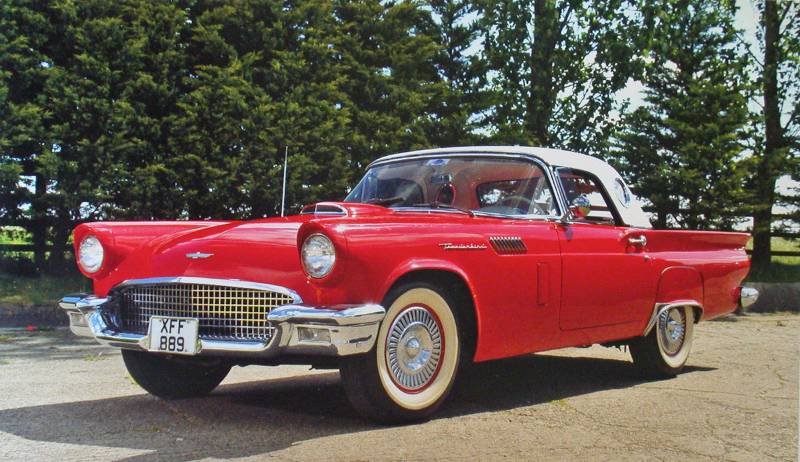


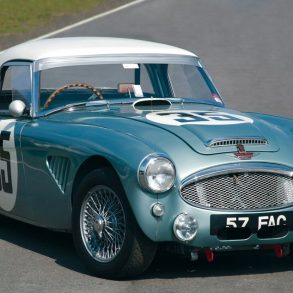
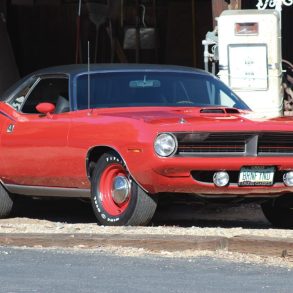
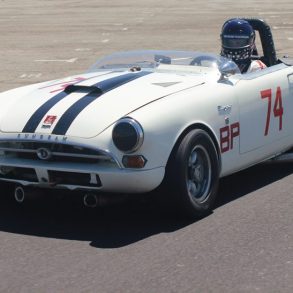

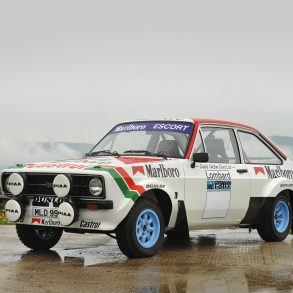

Good story, I have purchased a 55 T Bird and currently restoring for my wife. It’s been a lot of work but will be well worth it when I’m finished. She will be so happy to drive it.
Have a sweet 1957 Babybird E-Code for sale 46,000 miles garaged for 20 years. Email for details!
If you still have the tbird, my email is, [email protected]
Interested, thanks
Can you give a detailed description of Bird?